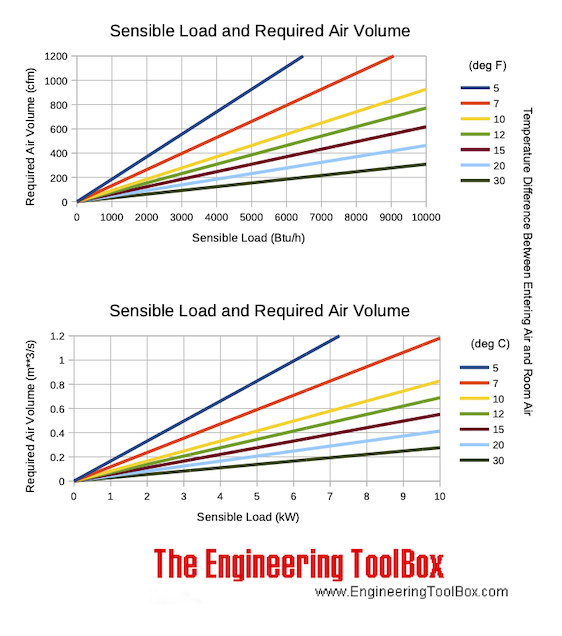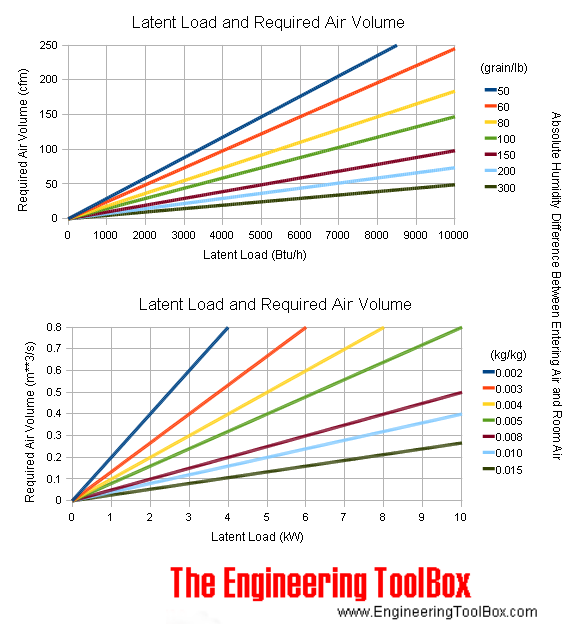Cooling Load - Latent and Sensible Heat
Latent and sensible cooling loads to consider when designing HVAC systems.
The design cooling load (or heat gain) is the amount of heat energy to be removed from a house by the HVAC equipment to maintain the house at indoor design temperature when worst case outdoor design temperature is being experienced.
There are two types of cooling loads:
- sensible cooling load
- latent cooling load
The sensible cooling load refers to the dry bulb temperature of the building and the latent cooling load refers to the wet bulb temperature of the building.
For summer conditions the humidity influence on the selection of the HVAC equipment and the latent load as well as the sensible load must be calculated.
Factors that influence sensible cooling load
- Glass windows or doors
- Sunlight striking windows, skylights, or glass doors and heating the room
- Exterior walls
- Partitions (that separate spaces of different temperatures)
- Ceilings under an attic
- Roofs
- Floors over an open crawl space
- Air infiltration through cracks in the building, doors, and windows
- People in the building
- Equipment and appliances operated in the summer
- Lights
Notice that below grade walls, below grade floors, and floors on concrete slabs do not increase the cooling load on the structure and are therefore ignored.
Other sensible heat gains are taken care of by the HVAC equipment before the air reaches the rooms (system gains). Two items that may require additional sensible cooling capacity from the HVAC equipment are
- duct work located in an unconditioned space
- ventilation air (air that is mechanically introduced into the building)
Sensible Heat Load and Required Air Volume Chart
Sensible heat load - heating or cooling - and required air volume to keep temperature constant at various temperature differences between entering air and room air are indicated in the chart below:
Factors that influence to the latent cooling load
Moisture is introduced into a structure through:
- People
- Equipment and appliances
- Air infiltration through cracks in the building, doors, and windows
Other latent heat gain is taken care of by the HVAC equipment before the air reaches the rooms (system gain).
Latent Heat Load and Required Air Volume Chart
Latent heat load - humidifying and dehumidifying - and required air volume to keep temperature constant at various temperature differences between entering air and room air are indicated in the chart below:
Related Topics
-
Air Conditioning Systems
Design of Air Conditioning systems - heating, cooling and dehumidification of indoor air for thermal comfort.
Related Documents
-
Cooling and Heating Equations
Latent and sensible cooling and heating equations - imperial units. -
Dehumidifiers
Classification of dehumidifiers. -
Great Sensible Heat Factor - GSHF
The Great Sensible Heat Factor is the ratio sensible to total heat in a cooling coil. -
Heat Index
Equivalent heat index vs. air temperature and relative humidity - in degrees Fahrenheit and Celsius. -
Heat Losses from Electrical Equipment
Heat loss from electrical equipment like switch-gear, transformers and variable frequency drives. -
Heating Up Applications - Energy Required and Heat Transfer Rates
Energy required to heat up a substance. -
Human Heat Gain
Heat gain from persons in air conditioned spaces - in btu/hr. -
Humid Air - Heating
Enthalpy change and temperature rise when heating humid air without adding moisture. -
HVAC Abbreviations
Commonly used HVAC abbreviations. -
Latent Heat Flow
Latent heat is the heat when supplied to or removed from air results in a change in moisture content - the temperature of the air is not changed. -
Room Sensible Heat Factor - RSHF
Room Sensible Heat Factor - RSHF - is defined as the sensible heat load divided by the total heat load in a room -
Sensible Heat Flow
Sensible heat is dry heat causing change in temperature but not in moisture content -
Sensible Heat Ratio - SHR
The ratio Sensible Heat (or Cooling) Load to the Total Heat (or Cooling) Load. -
Steam Heating Air
Calculate steam heated air systems.






